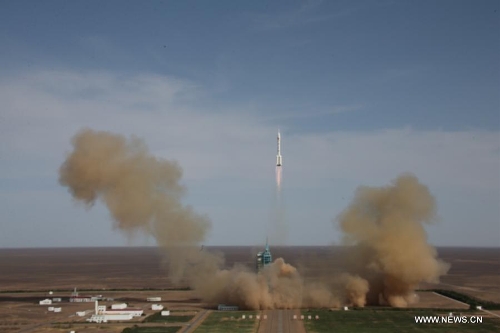Shenzhou-10 ready to dock

The Long March-2F carrier rocket carrying China's manned Shenzhou-10 spacecraft blasts off from the launch pad at the Jiuquan Satellite Launch Center in Jiuquan, Northwest China's Gansu Province, June 11, 2013. (Xinhua/Wang Jianmin)
The Shenzhou-10, China's fifth manned spacecraft, is set to dock with the target orbiter and space module Tiangong-1 Thursday, said China's official media.
The craft, which was carried by the Long March 2F rocket carrier and launched late Tuesday at the Jiuquan Satellite Launch Center in Northwest China's Gansu Province, will conduct a 15-day mission, its longest ever. It will perform two dockings, one automatic and a more difficult manual procedure, which was first carried out by the Shenzhou-9.
Wu Ping, spokeswoman for China's manned space program, said Monday the docking technologies and capabilities of the manned craft would be tested during the mission, Xinhua reported.
Observers say that the successful launch of the Shenzhou-10 marks a significant step to the building of a space station in 2020 and means that China's essential space technology has matured and formally transferred from an experimental period to one of applications.
"Compared with China's previous nine Shenzhou spacecraft, which saw technological improvements every time, this one is equipped with a series of stable technologies for transporting astronauts and supplies to orbit module Tiangong-1," Song Zhongping, a military affairs expert, told the Global Times Wednesday.
The Shenzhou-10 inherited most of the technologies of Shenzhou-9. "Not only the technologies but also the types and procedures of missions that astronauts should carry out will be settled after this mission, which is seen as a final test for basic technologies like docking," Song said.
Once the technologies are proven effective, many types of equipment needed for the spacecraft will be ready for small-scale production that would accelerate future spacecraft tests, he noted.
The Shenzhou-10 will be the fifth craft that docks with the Tiangong-1, which was sent into space in 2011 and entered the appropriate orbit in late May for the docking mission.
However, some components on the Tiangong-1, which were designed to function for only two years, may not be in an optimal state, and experts worry that there could be unknown risks that the moisture and microbes left from previous missions might have grown and become hazardous.
"Those are also the risks astronauts will very likely be facing if we have a real space lab," Hu Haifeng, designer with the China Aerospace and Technology Corporation who participated in the design of the Shenzhou-7 rocket carrier system, told the Global Times Wednesday, adding that this is another opportunity for China to prepare for a real space station.
The three astronauts on board, Nie Haisheng, Zhang Xiaoguang and Wang Yaping, held a celebration inside the spacecraft of China's traditional Dragon Boat Festival Wednesday by having sticky rice dumplings, known as zongzi.
Apart from tests and observations, Wang Yaping, China's second female astronaut after Liu Yang, will be giving a lecture to Chinese middle and elementary school students for the first time, explaining motion in a microgravity environment.
"This is the first time we can have such an activity in the module. It shows that astronauts can perform more complicated tasks in the module and that we are confident in our technologies," said Hu, adding that communication with Earth from space could raise people's interest in science and space exploration.
While the launch increased national pride among Chinese people, it also drew global attention.
Stephen Noerper, an East Asia analyst with the New York-based Korean Society, told South Korea's Chosun Ilbo that the space project showed the transformation of China in terms of economy, politics and technology.
Dean Cheng, a research fellow at the Washington-based Heritage Foundation, told CNN that China has overtaken the US at least temporarily and it would not be engaged in a space race with the US as they have a long-term plan and would stick to it.
However, a Guardian report said the rendezvous and docking techniques were mastered by the US and former Soviet Union decades ago, and the 10.5 meter-long Tiangong-1 is only a trial module, not a fully fledged space station.
Hu admitted that China still lags behind the US in terms of space exploration technology, but as the third country to independently master basic techniques of human spaceflight, space walking and space docking, China has made great progress.
Xinhua contributed to the story
Special Coverage:
